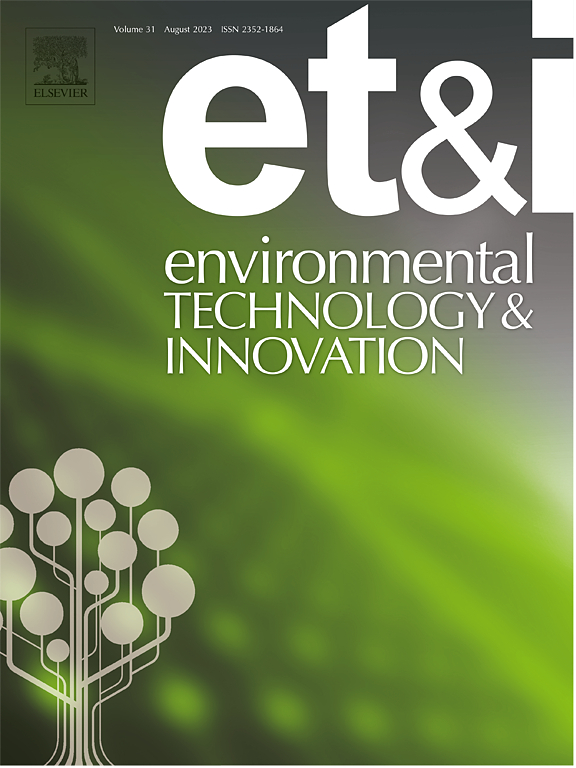功能膜覆盖对污泥堆肥中氮硫转化的影响及其微生物作用机理
IF 6.7
2区 环境科学与生态学
Q1 BIOTECHNOLOGY & APPLIED MICROBIOLOGY
引用次数: 0
摘要
氮和硫是促进植物生长的必需营养素。研究堆肥过程中氮、硫的转化机理,对提高堆肥产品肥力具有重要的指导意义。功能膜覆盖的好氧堆肥系统一直证明其加速堆肥成熟的能力。然而,氮和硫在该系统中的转化机制,以及相关的微生物过程,仍然没有充分了解。在这项研究中,研究了功能膜覆盖(FM)对污泥堆肥过程中氮和硫化合物转化的影响,并探讨了氮和硫循环的微生物机制。结果表明,亚硝酸盐氨化、亚硝酸盐氧化和硝酸盐还原是堆肥初期氮素转化的主要步骤。中后期反硝化作用加剧,导致有效氮含量下降。硫酸盐还原、硫化物氧化和硫代硫酸盐失衡是硫转化的主要步骤,硫代硫酸盐氧化强度逐渐增大。FM抑制了反硝化、亚硫酸盐还原和硫代硫酸盐的失衡,从而使氮和硫的损失分别降低了14.1% %和8.1 %,有效氮和有效硫含量分别提高了14.9% %和9.6% %。参与氮循环的主要参与者有硝基螺旋菌、黄体单胞菌、链霉菌、假黄单胞菌、放线菌和假单胞菌。硫循环涉及多种功能微生物,其在堆肥过程中的演替尤为突出。综上所述,FM系统可以作为提高污泥堆肥产品肥力的有效途径。本文章由计算机程序翻译,如有差异,请以英文原文为准。
The impact of functional membrane covering on nitrogen and sulfur transformation of sludge composting and its microbial action mechanism
Nitrogen and sulfur are essential nutrients for promoting plant growth. Investigating the transformation mechanisms of nitrogen and sulfur during composting has substantial guiding significance for enhancing the fertility of composting products. Functional membrane-covered aerobic composting systems have consistently demonstrated their ability to accelerate compost maturation. However, the transformation mechanisms of nitrogen and sulfur within this system, as well as the associated microbial processes, remain inadequately understood. In this study, the impact of functional membrane coverage (FM) on the transformation of nitrogen and sulfur compounds during sludge composting was studied, along with an investigation into the microbial mechanisms underlying nitrogen and sulfur cycling. The results showed that nitrite ammonification, nitrite oxidation, and nitrate reduction were the main nitrogen transformation steps during the early days of composting. In the middle and later stages, the denitrification intensified, leading to a decrease in available nitrogen content. Sulfate reduction, sulfide oxidation, and thiosulfate dispropotionation constituted the primary sulfur transformation steps, with thiosulfate oxidation intensity gradually increasing. FM inhibited denitrification, sulfite reduction, and thiosulfate dispropotionation, thereby reducing nitrogen and sulfur loss by 14.1 % and 8.1 %, respectively, and increasing available nitrogen and available sulfur content by 14.9 % and 9.6 %, respectively. The main participants involved in nitrogen cycle were Nitrospira, Luteimonas, Streptomyces, Pseudoxanthomonas, Actinomadura, and Pseudomonas. A wide variety of functional microorganisms were involved in the sulfur cycle, with their succession during composting being especially prominent. In summary, the FM system can serve as an effective approach to enhance the fertility of sludge compost products.
求助全文
通过发布文献求助,成功后即可免费获取论文全文。
去求助
来源期刊

Environmental Technology & Innovation
Environmental Science-General Environmental Science
CiteScore
14.00
自引率
4.20%
发文量
435
审稿时长
74 days
期刊介绍:
Environmental Technology & Innovation adopts a challenge-oriented approach to solutions by integrating natural sciences to promote a sustainable future. The journal aims to foster the creation and development of innovative products, technologies, and ideas that enhance the environment, with impacts across soil, air, water, and food in rural and urban areas.
As a platform for disseminating scientific evidence for environmental protection and sustainable development, the journal emphasizes fundamental science, methodologies, tools, techniques, and policy considerations. It emphasizes the importance of science and technology in environmental benefits, including smarter, cleaner technologies for environmental protection, more efficient resource processing methods, and the evidence supporting their effectiveness.
 求助内容:
求助内容: 应助结果提醒方式:
应助结果提醒方式:


